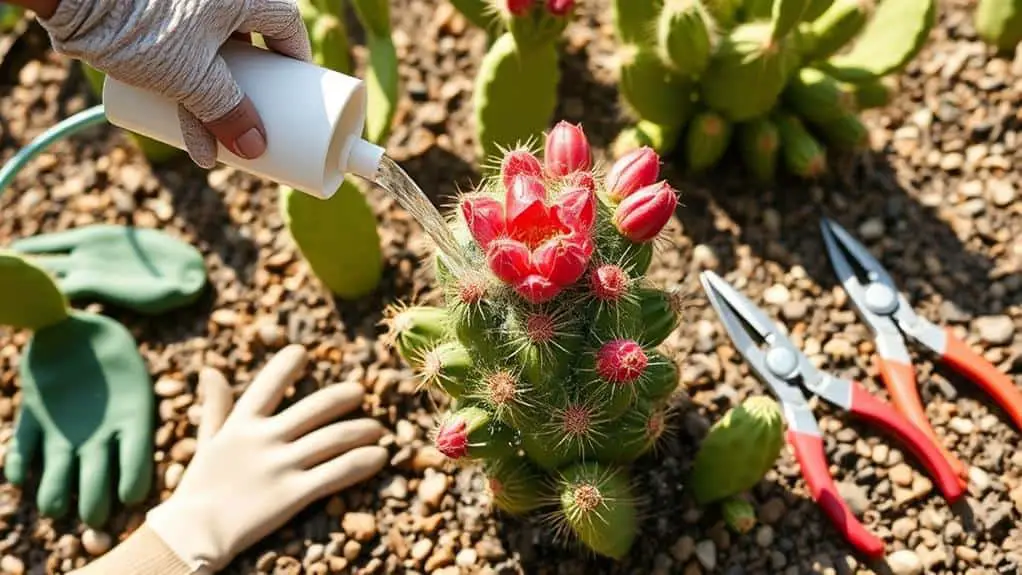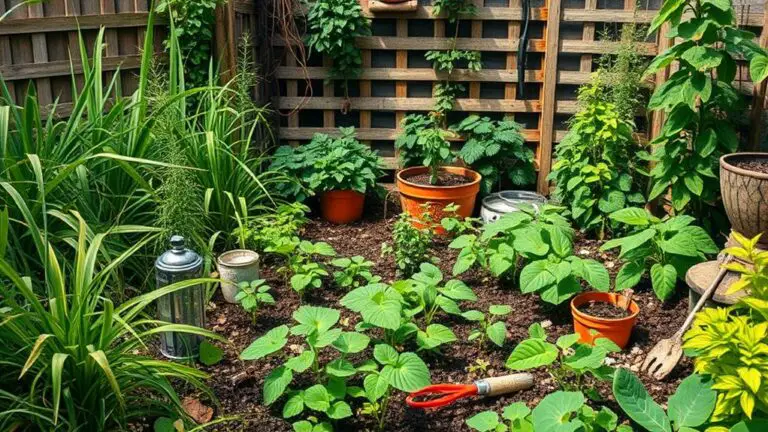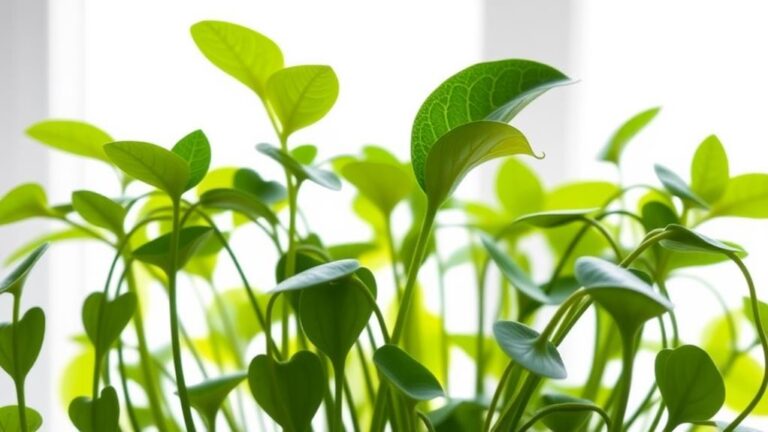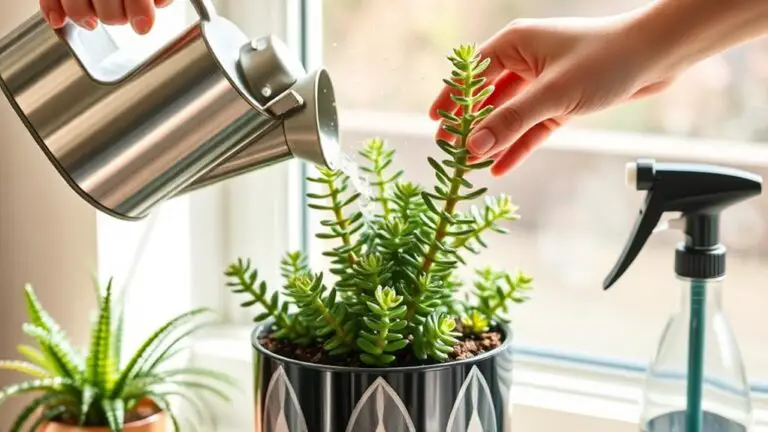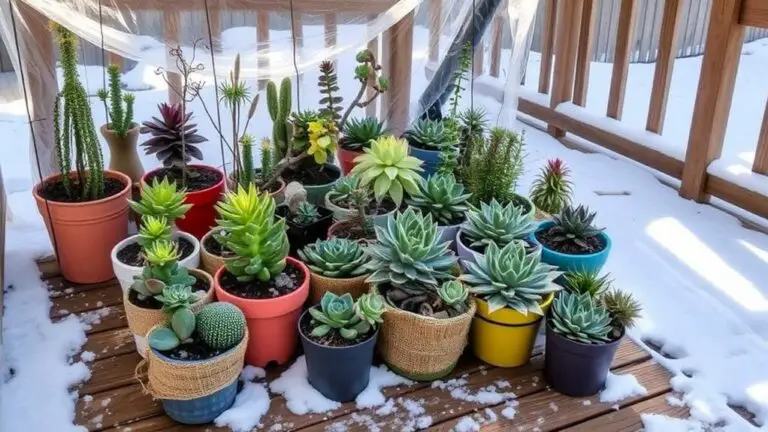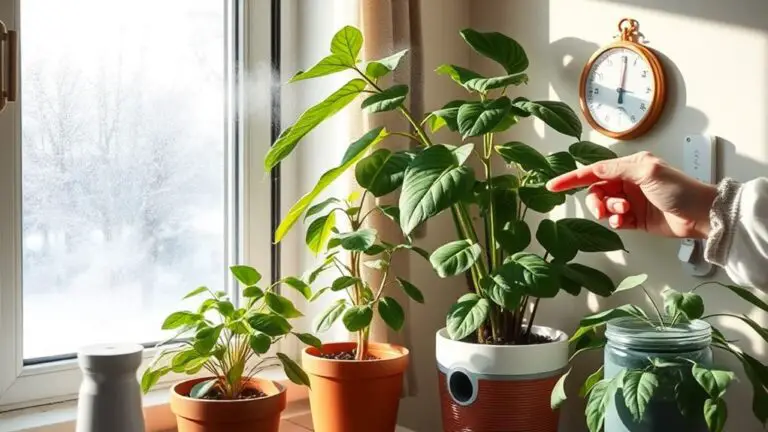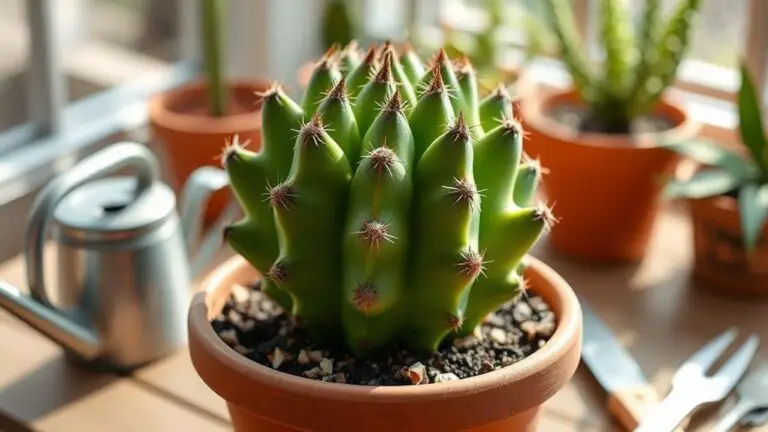7 Steps to Care for Your Opuntia Cactus
Caring for your Opuntia cactus might seem straightforward, but guaranteeing it thrives requires attention to detail across seven key steps. First, you'll need to choose the right variety for your specific climate. From there, preparing ideal soil with a pH between 6.0 and 7.5 and planting it in a sunny spot are essential. Watering only when the top inch of soil is dry and adjusting this with the seasons helps prevent root rot. Pruning in the right season and correctly harvesting pads and fruits will keep your cactus healthy and productive. So, how do you guarantee each step is executed perfectly?
Choose the Right Variety
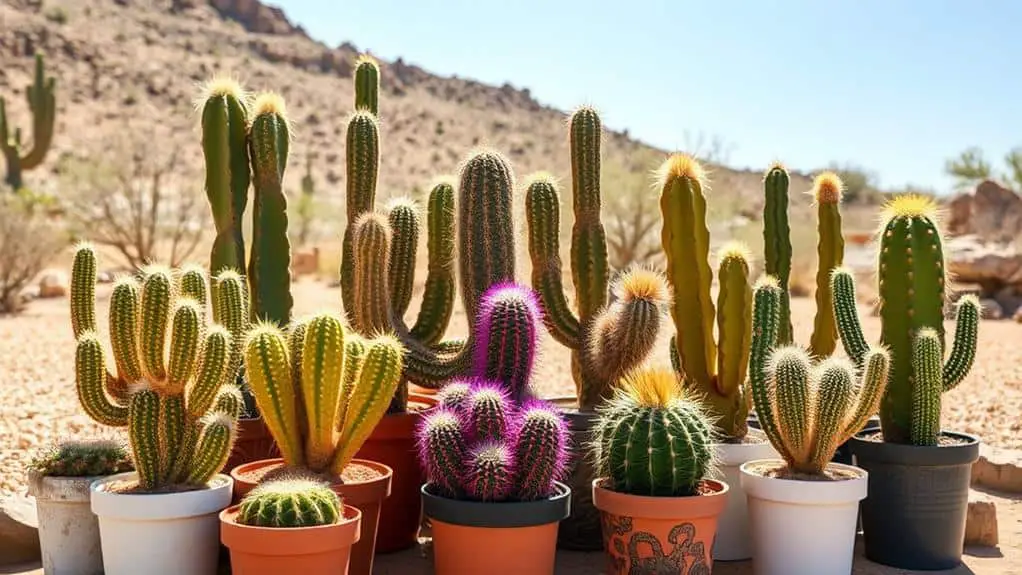
When choosing the right variety of Opuntia cactus, it's important to take into account your climate and specific needs. The right choice can make a big difference in how well your cactus thrives.
For those in cooler climates, Opuntia humifusa is a suitable option. It boasts excellent cold-hardiness, thriving in zones 4-9 and enduring snow and ice.
If you prefer a tall cactus with the bonus of sweet, edible fruit, Opuntia ficus-indica is your best bet. This variety flourishes in warmer zones 8-11, reaching heights of 10-15 feet.
For a unique aesthetic, consider Opuntia microdasys, also known as Bunny Ears. It grows 3-5 feet tall, with yellow flowers and purple/red fruit, adding a striking look to your garden.
For those seeking a spineless option, Opuntia cacanapa Ellisiana is perfect. This cactus grows 3 feet tall and 4-6 feet wide, offering cold hardiness and mid-summer blooms without the spines.
Prepare Ideal Soil

Creating the perfect soil mix for your Opuntia cactus is vital for its health and growth. Start by using a well-draining soil mix. Combine standard potting soil with coarse sand, perlite, or pumice. This combination improves drainage and aeration, essential for preventing root rot.
Your Opuntia cactus will thrive in soil with a slightly acidic to neutral pH level, ideally between 6.0 and 7.5. This range helps the plant absorb nutrients properly and stay healthy.
Make certain your pot has drainage holes to avoid waterlogging. Waterlogged soil can lead to root rot, a common issue with Opuntia cacti. To keep your cactus in peak condition, repot every 2-3 years or when you see roots coming out of the drainage holes.
When repotting, always use a fresh soil mix. This guarantees your cactus has a continuous supply of nutrients and maintains good drainage.
Before planting your Opuntia, allow any cuttings to callus for about a week. This step is vital to prevent rot and encourage successful rooting.
Taking these steps will help your Opuntia cactus flourish and stay healthy for years to come.
Planting Techniques

When planting your Opuntia cactus, make sure to use a well-draining soil mix that includes potting soil, coarse sand, and perlite or pumice.
Position the cactus in a sunny spot where it will get at least six hours of bright sunlight each day.
Be careful with watering; let the soil dry out completely between waterings, especially during the first month.
Ideal Soil Mix
Guaranteeing a healthy start for your Opuntia cactus begins with choosing the right soil mix. For Opuntia cacti, a well-draining soil mix is vital. Combine potting soil with coarse sand, perlite, or pumice to make certain the roots stay healthy and develop properly. This mix helps prevent the dreaded root rot, which is a common issue for these plants.
Make sure the pot you're using has drainage holes. These holes are critical because they allow excess water to escape, keeping the soil from becoming waterlogged. When you're planting your cactus, position it at the same soil level it was growing in before. This helps avoid rot and promotes proper growth.
If you're looking into propagation, let the cut surfaces of the cactus pads callus over for about a week before planting them. This step maximizes the success of growing new plants. Once callused, plant the pads upright in the same well-draining cactus mix.
The ideal soil pH for Opuntia cacti is slightly acidic to neutral, ranging from 6.0 to 7.5. This pH range enhances nutrient availability, guaranteeing your cactus gets everything it needs to thrive.
Follow these steps, and your Opuntia cactus will have a solid foundation for growth.
Proper Watering Techniques
After setting up the right soil mix, the next step to guarantee your Opuntia cactus thrives is mastering proper watering techniques. First, remember to water your prickly pear cactus only when the top inch of soil is completely dry. This helps prevent overwatering, which can cause root rot.
During the active growing season, which happens in spring and summer, water every 7-10 days. Make certain the soil dries out entirely between waterings to keep your cactus healthy.
When fall and winter arrive, the cactus enters a dormant period. You'll need to considerably reduce watering to avoid excess moisture and potential cold damage.
Here are some key tips to keep in mind:
- Apply water directly to the soil, not the pads, to prevent rot.
- Confirm your cactus is in well-draining soil to keep the roots healthy.
- Place your cactus in a spot with bright light for ideal growth.
Following these steps will help you provide proper care for your Opuntia cactus. By paying attention to the soil's dryness and adjusting your watering schedule with the seasons, your cactus will flourish.
Keep an eye on it, and enjoy watching it grow!
Watering Schedule

When watering your Opuntia cactus, you'll want to check that the top inch of soil is completely dry before adding more water, which usually means watering every 7-10 days during spring and summer.
Make sure to let the soil dry out thoroughly between waterings to avoid root rot.
In the fall and winter, cut back on watering and let the soil stay dry for longer periods.
Frequency and Timing
To keep your Opuntia cactus thriving, adhere to a specific watering schedule tailored to the seasons. During the active growing season (spring and summer), you'll need to water your Opuntia every 7-10 days.
Make certain the soil is completely dry before adding more water. This frequency guarantees your cactus gets the hydration it needs without risking root rot.
In the fall and winter months, your Opuntia enters a dormant phase. Reduce watering to once every 2-3 weeks, or until the soil is dry.
Overwatering during this period can be harmful since the cactus's growth slows down. Here are some quick tips to remember:
- Check soil dryness: Always check the top inch of soil before watering.
- Adjust for new plants: Newly planted pads don't need water for the first month.
- Stick to the routine: Consistency helps prevent shriveling and thin pads.
Seasonal Adjustments
Understanding the seasonal adjustments for your Opuntia cactus's watering schedule is paramount for its health.
During the active growing season, which spans spring and summer, you should water your Opuntia every 7-10 days. Be sure to let the soil dry out completely between waterings. This prevents overwatering, a common issue that can lead to root rot. Check the top inch of soil for dryness before adding water.
As fall approaches, your cactus enters its dormant phase, requiring much less water. During this period, only water when the soil is completely dry. You might find yourself watering just once a month or even less. This reduction in water helps your cactus conserve energy and prevents overwatering.
Environmental factors also play a big role. If you live in a hotter, drier climate, you might need to water a bit more frequently. Conversely, in cooler or more humid areas, you'll need to water less.
For new plants, avoid watering for at least a month. This helps the roots establish themselves without the risk of rot.
Sunlight Requirements
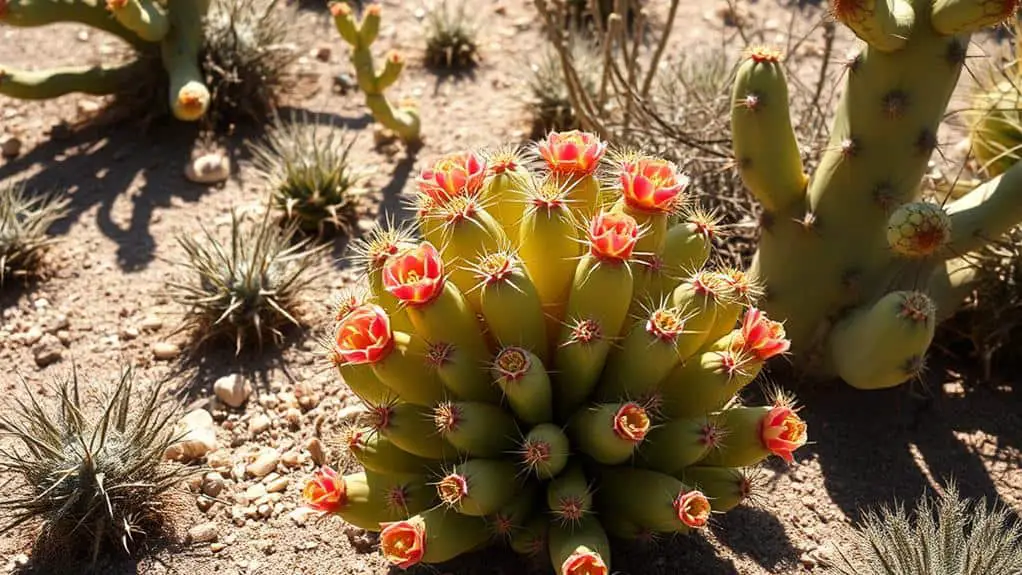
Opuntia cacti need a substantial amount of sunlight, typically 6 to 8 hours of bright light daily, to guarantee they grow robustly and stay healthy. They thrive best in full sun, making a south-facing window ideal for indoor placement.
However, it's essential to gradually acclimate your cactus to increased light conditions to prevent sunburn or stress. If you live in extremely hot climates, consider providing afternoon shade to protect your cactus from overheating.
While Opuntia cacti can tolerate indirect light, their growth may slow down markedly without direct sunlight. To make sure your cactus gets the light it needs, keep these tips in mind:
- Gradual Acclimation: Slowly introduce your cactus to more light to avoid sunburn.
- South-Facing Windows: Place your cactus in a spot that gets plenty of full sun.
- Afternoon Shade: In hot climates, offer some shade during the hottest part of the day.
These steps will help you create the perfect environment for your Opuntia cactus.
Always remember, the right balance of bright sunlight and occasional shade can make all the difference in keeping your cactus healthy and thriving.
Pruning and Maintenance

When it comes to pruning and maintaining your Opuntia cactus, timing is key. The best time to prune is in spring or early summer when the cactus is growing actively. Start by using sterilized, sharp tools to make clean cuts on any damaged or overgrown pads. This minimizes injury and helps your cactus stay healthy.
Allow the cut surfaces to callus for about a week before watering. This step is essential to prevent infections and rot. Removing no more than one-third of the pads at a time will also help avoid stressing your cactus and promote healthy regrowth.
| Step | Description | Tips |
|---|---|---|
| Timing | Prune in spring or early summer | Cactus is actively growing |
| Tools | Use sterilized, sharp tools | Minimize injury |
| Callusing | Let cuts callus for a week | Prevent infection and rot |
| Quantity | Remove no more than one-third of pads | Avoid stressing the plant |
| Disposal | Discard or use pads for propagation | Handle with gloves |
You can discard the removed pads or use them for propagation. Just handle them with gloves to avoid injury from the spines and glochids. Following these steps will help you maintain a healthy and beautiful Opuntia cactus. Keep up the good work, and you'll have a thriving cactus garden in no time!
Harvesting and Uses

After you've finished pruning and maintaining your Opuntia cactus, it's also important to know how and when to harvest its pads and fruit.
You should harvest pads, or nopales, when they're young and tender, usually in spring or early summer. Be careful not to remove more than one-third of the plant to keep it healthy.
The fruit, called tuna, is best harvested in September when the glochids fall off, signaling ripeness. To detach the fruit, twist gently without pulling.
When you clean harvested pads and fruit, use tongs to avoid contact with the spines and glochids, which can irritate your skin.
After cleaning, you'll find that both the pads and the fruit are quite versatile.
- Nopales: They can be eaten raw in salads or cooked in various dishes.
- Tunas: Perfect for making jams, juices, or desserts, with a taste similar to melon or kiwi.
- Roasting pads: This method helps eliminate glochids, making them safer and more enjoyable to eat.
Frequently Asked Questions
How Do You Take Care of Opuntia Cactus?
You need to give your Opuntia cactus full sun, water it only when the top inch of soil is dry, use well-draining soil, fertilize properly, and protect it from frost if it's a non-hardy variety.
How Often Do You Water an Opuntia Cactus?
You should water your Opuntia cactus every 7-10 days during spring and summer, only when the top inch of soil is dry. Reduce watering considerably in fall and winter. Watch for signs of over- or underwatering.
How Much Light Does Opuntia Need?
Your Opuntia cactus needs 6 to 8 hours of bright, direct sunlight daily. Place it near south-facing windows indoors or in full sun outdoors. Gradually acclimate it to new light conditions to avoid sunburn.
What Do Prickly Pear Cactus Need to Survive?
To guarantee your prickly pear cactus thrives, provide well-draining sandy soil, full sun exposure, and minimal water. Let the soil dry completely between waterings. Fertilize sparingly and choose the right variety for your temperature zone.
Conclusion
Caring for your Opuntia cactus is easier than you think. Just choose the right variety for your climate, plant it in well-draining soil, and place it in a sunny spot. Remember to water only when the soil is dry, and give it a good prune in spring or summer. Harvesting pads and fruits at the right time will reward you with healthy, tasty treats. Follow these steps, and you'll have a thriving cactus in no time!

